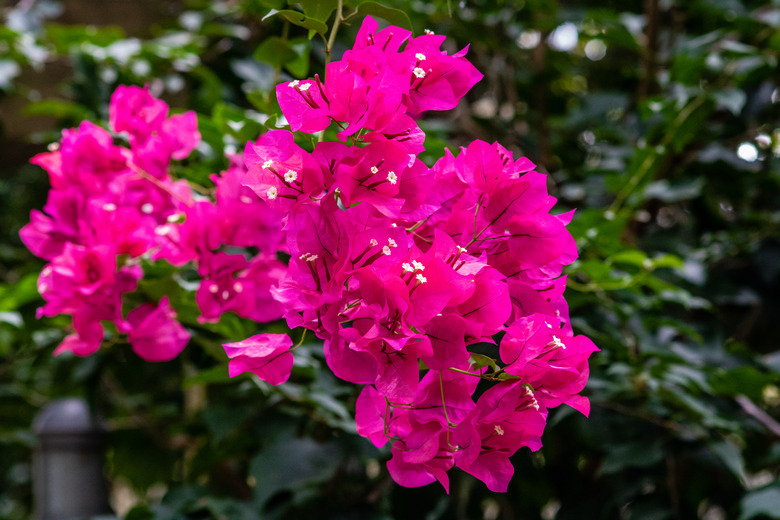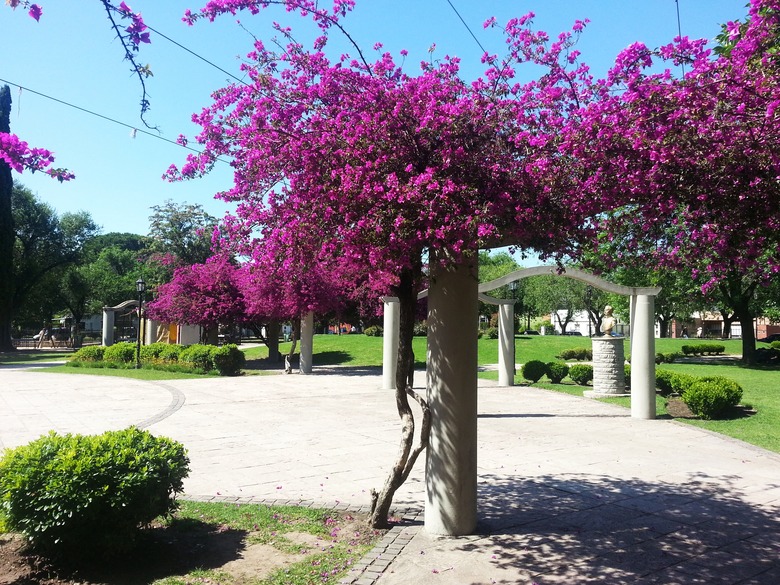Facts About Flowering Bougainvillea
Native to South America, bougainvilleas (Bougainvillea spp.) are woody, thorny, climbing vines that produce colorful floral displays. There are about 18 species in all. These tropical vines are hardy in U.S. Department of Agriculture zones 9 to 11.
Facts About Flowering Bougainvillea
- The "flowers" that
bougainvilleas are prized for are not true flowers. Rather, they are modified leaves known as bracts. These bracts surround the true bougainvillea flowers, which are white and tubular and measure about an inch in diameter.
- The bracts of bougainvillea come in a range of colors depending on the species and cultivar, including many shades of red, pink, purple, yellow, orange and white.
- Because of the appearance of the bracts, bougainvillea flowers are also known as paper flowers.
- Bougainvillea flowering is affected by sunlight. At least 8 hours of sun a day is ideal for these plants. When the vines receive too much shade, blooming is reduced.
- Bougainvillea vines flower throughout the year but will bloom most profusely when exposed to intense light and warm temperatures during the day and long nights.
The "flowers" that bougainvilleas are prized for are not true flowers. Instead, they are modified leaves known as bracts.
Common Bougainvillea Species
Only a few of the 18 species of bougainvillea are common in cultivation, including the lesser bougainvillea (Bougainvillea glabra, zones 9 to 11) and the greater bougainvillea (Bougainvillea spectabilis, zones 9 to 11). These species are similar in appearance, although the greater bougainvillea has somewhat longer flower bracts than the lesser bougainvillea.
Is Bougainvillea a Perennial?
Bougainvilleas are perennial plants in their natural habitat and when grown in USDA hardiness zones 9 to 10. That means they survive for more than one growing season.
When they are grown in colder zones, however, they are treated as annuals. Bougainvilleas can be grown in containers as well.
Care for Flowering Bougainvillea
Bougainvilleas need proper care to produce the colorful displays they are known for. The care encompasses the water, fertilizing and pruning requirements of these vines.
Watering
Bougainvilleas are native to arid regions of South America and perform well under dry conditions. Therefore, while you should water these vines during the growing season, you can allow the soil to dry out between waterings. According to the Clemson Cooperative Extension, a pH just above 6.0 is perfect for these plants.
Tip
Allow the soil around the bougainvilleas to dry out between waterings.
Pruning
Bougainvillea vines sometimes need pruning to shape and control their size. Be sure to use gloves and exercise caution to avoid injury by the vine's long, sharp thorns.
The best time to prune is after the plant has flowered in the summer. Late winter or early spring are also good times to prune. If you prune at the wrong time, you may end up with fewer flowers temporarily.
Warning
When pruning, use gloves and exercise caution to avoid injury by the vine's long, sharp thorns.
Fertilizing
A flowering bougainvillea benefits from the application of a general-purpose fertilizer when it is actively growing. Look for a balanced 10-10-10 formula, which contains equal amounts of nitrogen, potassium and phosphorus.
It is important not to overfeed your bougainvillea vines, however, as too much nitrogen stimulates foliage growth. If you are growing bougainvillea as a perennial, withhold fertilizer during the winter when the plant is dormant.
References
- North Carolina State Extension: Bougainvillea
- Clemson Cooperative Extension: Bougainvillea
- Missouri Botanical Garden: Bougainvillea (group)
- University of Florida IFAS Extension: Bougainvillea
- North Carolina State Extension: Bougainvillea glabra
- North Carolina State Extension: Bougainvillea spectabilis

